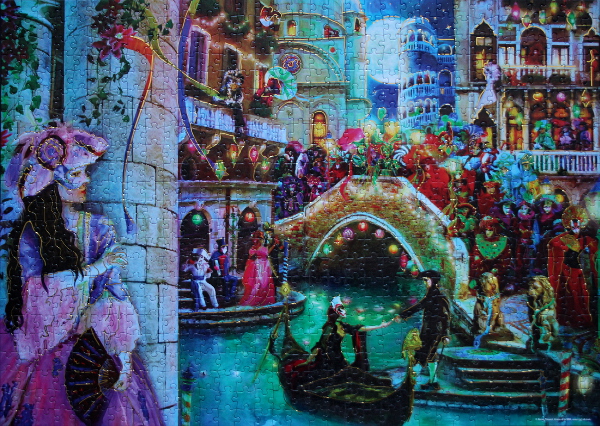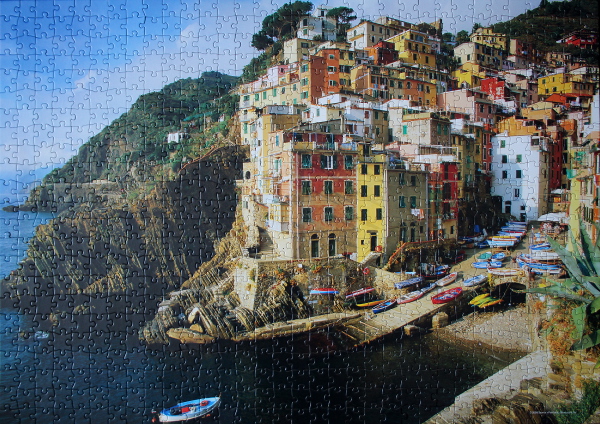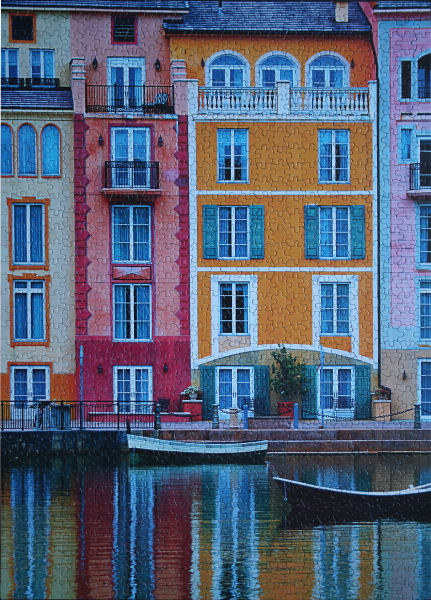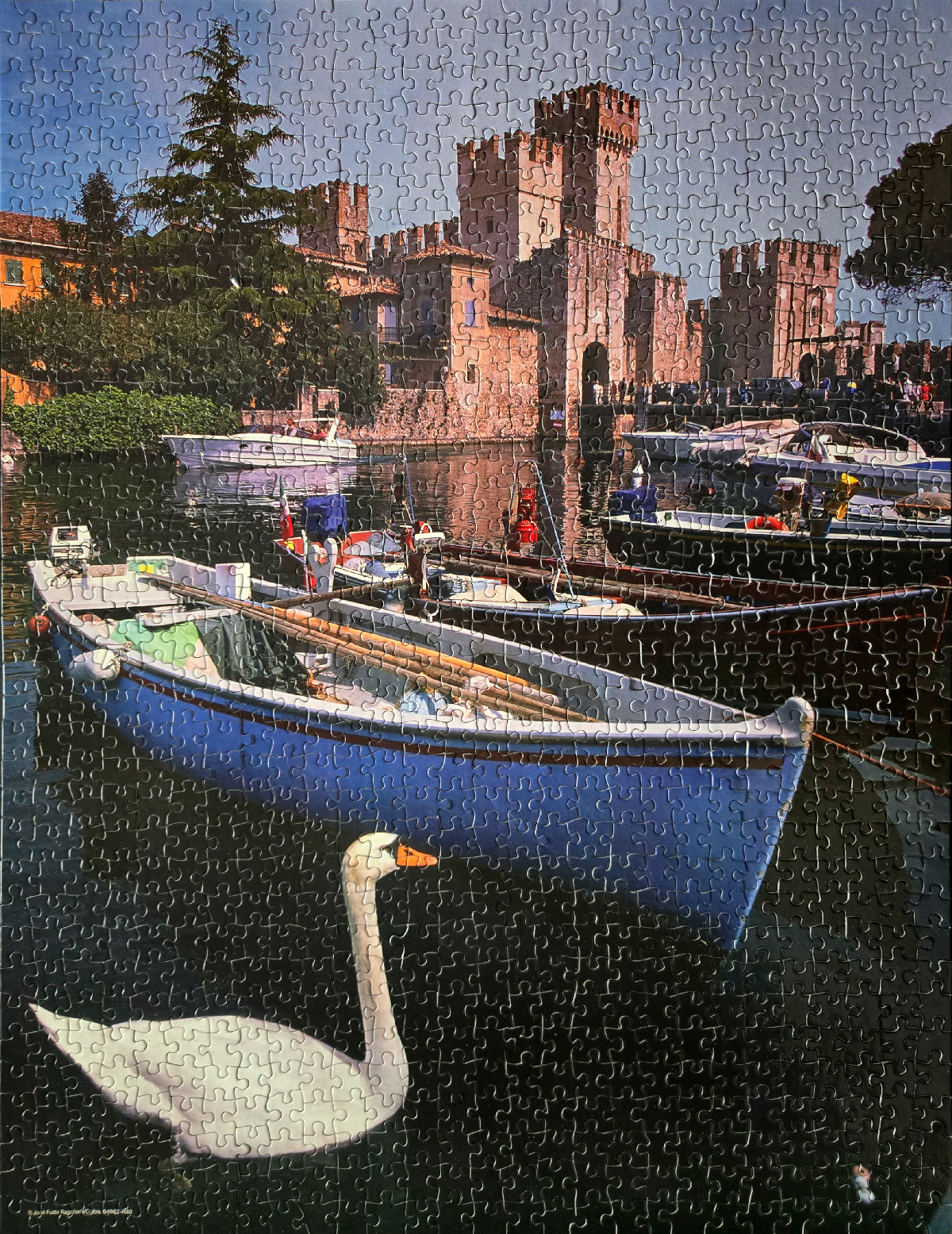
Size: 1000 pieces
Available for purchase on eBay
Dimensions: 51.12 cm x 66.52 cm
Manufacturer: Mega Brands
Photographer: José Fuste Raga
Box: photo
Tag: Italy
Piemonte
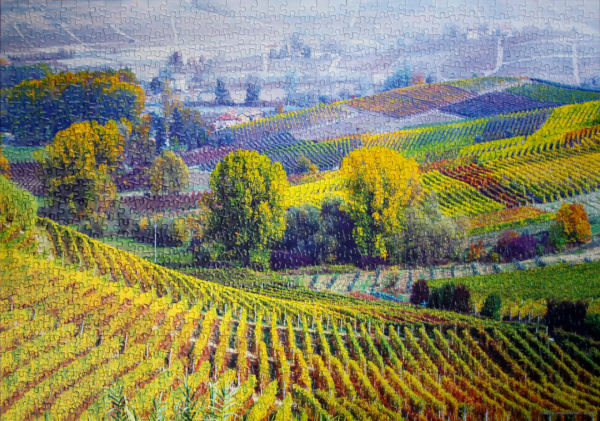
Size: 1000 pieces
Available for purchase on eBay
Dimensions: 48.26 cm x 68.58 cm
Manufacturer: The Canadian Group, #11123
Photographer: Freesurf/Stock.Adobe.com
Box: photo
Late afternoon in Italy
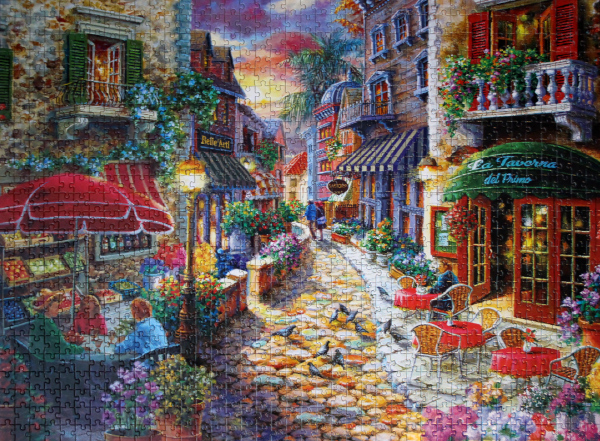
Size: 1000 pieces
Available for purchase on eBay
Dimensions: 51 cm x 68 cm
Manufacturer: Cra-Z-Art, #1600
Artist: Nicky Boehme
Box: photo
Cinque Terre Splendor
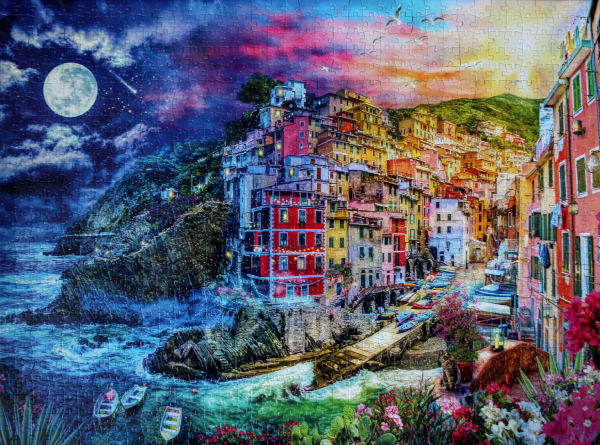
Size: 1000 pieces
Available for purchase on eBay
Dimensions: 50 cm x 68 cm
Manufacturer: Buffalo Games, 11840
Box: photo
Puzzle: Carnival Moon by Aimee Stewart
Size: 750 pieces
Dimensions: 67.94 cm x 48.10 cm
Producer: Mega Puzzles, Reflections series, 2015, CxC28 ASST DFD77, 966B, A11055LP, #50572
Artist: Aimee Stewart
Puzzle: Beautiful, vibrant puzzle of a street during a carnival – an uplifting and festive image. The variety of bright, well-separated colours and distinct gradients, in combination with easily-manageable 750 well-fitting pieces makes this puzzle a breeze to assemble. Good places to start are the pillar at the left and the woman standing by it, the moon, sky and tower near it, the bridge, the boat, and the water. Red and pink dresses are distinct, as are the balustrades, steps, and the lights under the bridge. The rest of the pieces fall into place easily.
Puzzle: Riomaggiore
Size: 750 pieces
Dimensions: 48.10 cm x 68 cm
Producer: Mega Puzzles, Windows to the World series, 2008, No.50580, 8006528 FO
Photographer: John and Debora Scanlan
Puzzle: Beautiful puzzle, lots of small detail adding to the challenge, but larger areas of gradient colours and the manageable size of 750 pieces make the assembly easier. Great places to start are the sky, the dark of the water, and the green hill bordering the sky. Bottom right region of uniform beige, the colourful stripes of the boats, and the ridged area near the water, in the bottom right quarter, as well as the close-up of a green plant at the bottom right, can be tackled next.
Larger buildings such as the orange/red one in the middle of the picture, yellow one next to it, and the white one ending the row of boats can be done next. From that point, it’s a bit more challenging, but vertical guides of completed buildings can help place the rest. Lovely imagery and fun to assemble.
Notes: Riomaggiore is a village in the province of La Spezia, situated in a small valley in the Liguria region of Italy. The village, dating from the early thirteenth century, is known for its historic character and its wine, produced by the town’s vineyards. [Wiki]
Riomaggiore is the most southern village of the Cinque Terre (“The Five Lands”), a rugged portion of coast on the Italian Riviera. Cinque Terre is comprised of five villages: Monterosso al Mare, Vernazza, Corniglia, Manarola, and Riomaggiore. Over the centuries, people have carefully built terraces on the rugged, steep landscape right up to the cliffs that overlook the sea. Part of its charm is the lack of visible corporate development. Paths, trains and boats connect the villages, and cars cannot reach them from the outside. [Wiki]
Puzzle: Untitled, Buildings along a waterfront
Size: 1000 pieces
Dimensions: 46 cm x 63 cm
Producer: Ceaco, package of 2 puzzles, 2013, #3210-1
Photographer: Lester A. Garcia
Original: photo
Puzzle: Together in the package with Paint pigment in the sun in Kathmandu, Nepal
Unfortunately untitled by the puzzle manufacturer, it took me a while to find the original photo on which this puzzle was based. Beautiful image and a very easy-flowing assembly, this puzzle is a pleasure. My 4-year old loved helping me with this puzzle, whereas normally 1000-piece ones are a bit too big for him to tackle. The clear vibrant colours of the buildings separated by distinct vertical and horizontal guides provided by the building boundaries and embellishments, split up by large windows, are very simple to assemble. The bottom part with its clear waterfront horizontal guide and reflections in calm water, ripples creating additional horizontal guides, logically follows.
Puzzle: San Joseph Church, Sicily, Italy
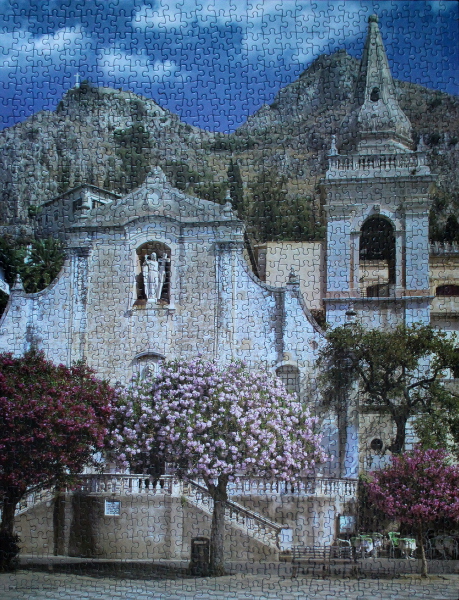 Size: 1000 pieces
Size: 1000 pieces
Dimensions: 51.12cm x 66.52cm
Producer: Hasbro, MB Puzzles, Big Ben, 2008, 04962-W42
Photographer: R. Kord/Robertstock
Puzzle: Not a completely trivial puzzle, but quite serene to put together with its tree blooms and a magnificent building. Good places to start are the border between the mountains and the sky, the outline of the church against the mountain, the horizontal guide of the pavement against the building base, the vertical guides of the pillars and tree trunks, the arch between the pillars of the bell tower, and the statue with the cross. That splits the puzzle up into smaller regions that are easier to tackle. The uniform white and beige of the walls, the balustrade, the pink blooms, and the pavement can be completed next. For the rest of the puzzle, good lighting is a plus.
Notes: I have found a lovely picture of this church at the Walks of Italy site.
It is situated in Taormina – a small town on the east coast of the island of Sicily, Italy, in the Province of Messina. Taormina has popular beaches on the Ionian sea, which is remarkably warm and has a high salt content. The present town of Taormina occupies the ancient site, on a lofty hill. Portions of the ancient walls may be traced at intervals all round the brow of the hill, the whole of the summit of which was evidently occupied by the ancient city. Numerous fragments of ancient buildings are scattered over its whole surface, including extensive reservoirs of water, sepulchres, tesselated pavements, etc., and the remains of a spacious edifice, commonly called a Naumachia, but the real purpose of which it is difficult to determine. [Wiki]
Puzzle: Santa Maria Della Salute, Venice, Italy
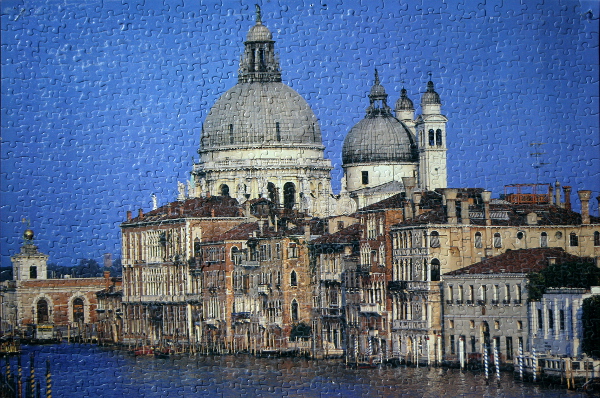
Size: 750 pieces
Dimensions: 59.69 cm x 39.37 cm
Producer: Sure-Lox, The Canadian Group
Puzzle: This puzzle is a bit challenging due to large areas of almost uniformed-coloured sky, and the tightly-fitting side-view of the buildings with many small details, but Sure-Lox pieces come to the rescue by fitting into place unambiguously. The domes of the church, its walls, and the border between the sky and the buildings are good places to start. The blue and white poles in the water, the lower building in the bottom left corner, the water, and the buildings in the bottom right are some of the easier regions to complete next. From that point on, the rest of the puzzle can be assembled.
Notes: Santa Maria della Salute, commonly known simply as the Salute, is a Roman Catholic church and minor basilica located in the Dorsoduro sestiere of the Italian city of Venice. It stands on a narrow finger of land between the Grand Canal and the Bacino di San Marco making the church visible when entering the Piazza San Marco from the water. The Salute is part of the parish of the Gesuati and is the most recent of the so-called plague-churches.
In 1630, Venice experienced an unusually devastating outbreak of the plague. As a votive offering for the city’s deliverance from the pestilence, the Republic of Venice vowed to build and dedicate a church to Our Lady of Health (or of Deliverance, Italian: Salute). The church was designed in the then fashionable baroque style by Baldassare Longhena, who studied under the architect Vincenzo Scamozzi. Construction began in 1631. Most of the objects of art housed in the church bear references to the Black Death. [Wiki]
Puzzle: Trevi Fountain, Italy
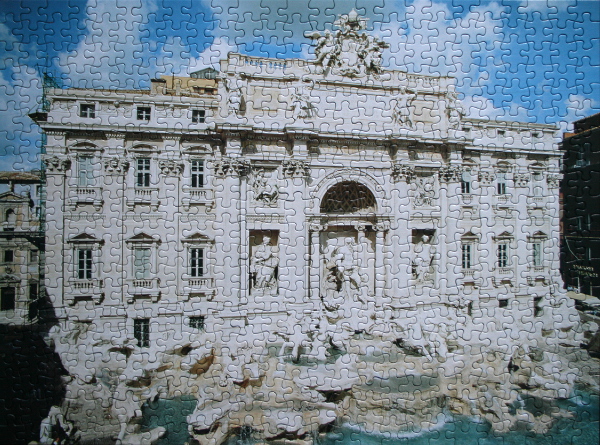
Size: 500 pieces
Dimensions: 48.3 cm x 35.6 cm
Producer: Sure-Lox, The Canadian Group, #42210-17
Puzzle: This puzzles was a little more challenging than a usual 500-piece puzzle, since so many parts of the building look alike and carry the same colour scheme. However, with Sure-Lox pieces fitting snugly into place, it was very pleasant to do nonetheless. The sky and water are best places to start, as are the dark areas on the edges. The windows, the balconies, the archway, the roof, and the regions close to the water are distinct enough to follow. The rest are a matter of completing the gaps between the earlier-placed pieces. I have done another 500-piece puzzle of a close-up of the Trevi Fountain.
Puzzle: Crash Course in Italian by Thomas Barbèy
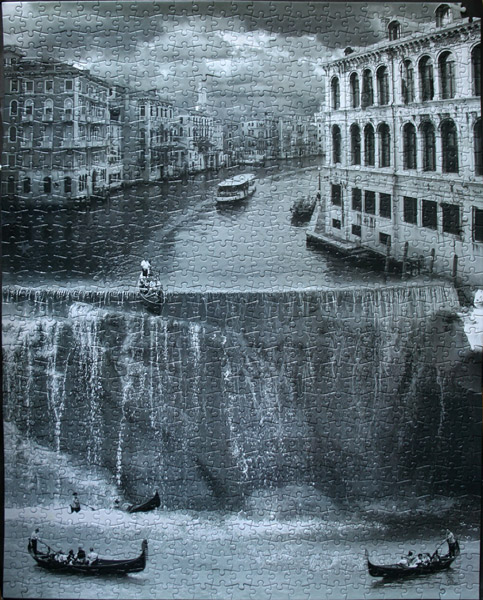
Size: 1000 pieces
Dimensions: 59.7 cm x 39.4 cm
Producer: TreeToys, 2004, Puzzle Art series
Artist: Thomas Barbèy
Original: print
Notes: Every single one of my images has to pass what I like to call the “So what?” test. If a combination of two or more negatives put together doesn’t touch me or have any particular meaning, I throw it out. I try to combine images and sometimes the results can be disappointing. A giant clock in the middle of the ocean can be an unusual image but if I look at it and say to myself, “So waht?” This means it isn’t good enough. If instead, an ocean liner is going down a “funnel-type” hole and I entitle it “shortcut to China,” it takes on a whole new meaning. The picture takes you into an imaginary world where you can see the captain telling the passengers to fasten their safety belts to get prepared for the descent.
At times I come up with ideas beforehand, try to materialize them and it works. At other times, it is an accident and the ideas come afterwards, when the image is already finished and the concept has yet to be understood. It is almost as if I am learning constantly through the process of creation. I travel a lot to take photographs of different things and places. Sometimes I use an image several years later, but only when it fits, like the perfect piece in a puzzle, and completes my latest project. Some images are composed of negatives that are separated by a decade in the actual time that I had taken them and only come to life when they found their perfect match. it’s the combination of two or more negatives that they give birth to a completely unsual vision, but most of all, the title I give the final image is the glue and the substance of the piece. [Thomas Barbèy]
Puzzle: Venetian Masks
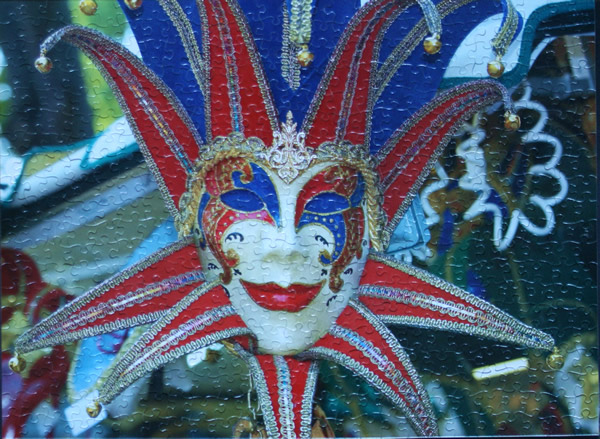
Size: 500 pieces
Dimensions: 48.26 cm x 35.56 cm
Producer: The Canadian Group, Sure-Lox
Notes: Venetian masks are a centuries-old tradition of Venice, Italy. The masks are typically worn during the Carnevale (Carnival of Venice), but have been used on many other occasions in the past, usually as a device for hiding the wearer’s identity and social status. The mask would permit the wearer to act more freely in cases where he or she wanted to interact with other members of the society outside the bounds of identity and everyday convention. It was useful for a variety of purposes, some of them illicit or criminal, others just personal, such as romantic encounters.
Venetian masks are characterized by their ornate design, featuring bright colours such as gold or silver and the use of complex decorations in the baroque style. Many designs of Venetian masks stem from Commedia dell’arte. They can be full-face masks (e.g. the bauta) or eye masks (e.g. the Columbina). [Wiki]
Puzzle: St. Mark’s Basilica, Italy
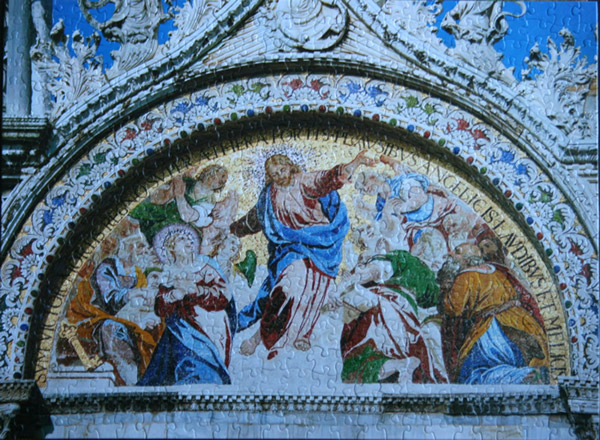
Size: 500 pieces
Dimensions: 48.26 cm x 35.56 cm
Producer: Sure-Lox
Notes: The Patriarchal Cathedral Basilica of Saint Mark is the cathedral church of the Roman Catholic Archdiocese of Venice, northern Italy. It is the most famous of the city’s churches and one of the best known examples of Byzantine architecture. It lies at the eastern end of the Piazza San Marco, adjacent and connected to the Doge’s Palace.
The exterior of the basilica is divided in three registers: lower, upper, and domes. In the lower register of the facade five round-arched portals, enveloped by polychrome marble columns, open into the narthex through bronze-fashioned doors. Above the central door round three bas-relief cycles of Romanesque art. The external cycle frames a 19th century gilded mosaic (Last Judgment) that replaced a damaged one with the same subject (during the centuries many mosaics had to be replaced inside and outside the basilica, but subjects were never changed). Mosaics about St Mark relics’ stories are in the lunettes of the lateral portals; the first on the left is the only one in the facade preserved from the 13th century. In the upper register, from the top of ogee arches, statues of Theological and Cardinal Virtues, four Warrior Saints and St Mark watch over the city. Above the large central window of the facade, under St Mark, the Winged Lion (his symbol) holds the book quoting “Pax Tibi Marce Evangelista Meus” (Peace to you Mark my evangelist). In the lunettes of the lateral ogee arches are four gilded mosaics renewed in the 17th century. In the center of the balcony the Greek Horses face the square. [Wiki]
Puzzle: Vatican, Italy
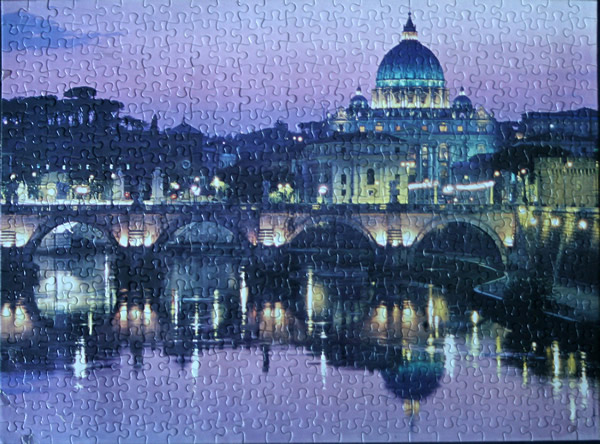
Size: 500 pieces
Dimensions: 48.4 cm x 35.5 cm
Producer: Sure-Lox
Notes: Vatican City or Vatican City State is a landlocked sovereign city-state whose territory consists of a walled enclave within the city of Rome, Italy. It has an area of approximately 110 acres, and a population of just over 800.
Vatican City was established in 1929 by the Lateran Treaty, signed by Cardinal Secretary of State Pietro Gasparri, on behalf of the Holy See and by Prime Minister Benito Mussolini on behalf of the Kingdom of Italy. Vatican City State is distinct from the Holy See, which dates back to early Christianity and is the main episcopal see of 1.2 billion Latin and Eastern Catholic adherents around the globe. Ordinances of Vatican City are published in Italian; official documents of the Holy See are issued mainly in Latin. The two entities even have distinct passports: the Holy See, not being a country, issues only diplomatic and service passports; Vatican City State issues normal passports. Very few passports are issued by either authority.
The Lateran Treaty in 1929, which brought the city-state into existence, spoke of it as a new creation (Preamble and Article III), not as a vestige of the much larger Papal States (756-1870) that had previously encompassed much of central Italy. Most of this territory was absorbed into the Kingdom of Italy in 1860, and the final portion, namely the city of Rome with Lazio, ten years later, in 1870. [Wiki]
Puzzle: Trevi Fountain
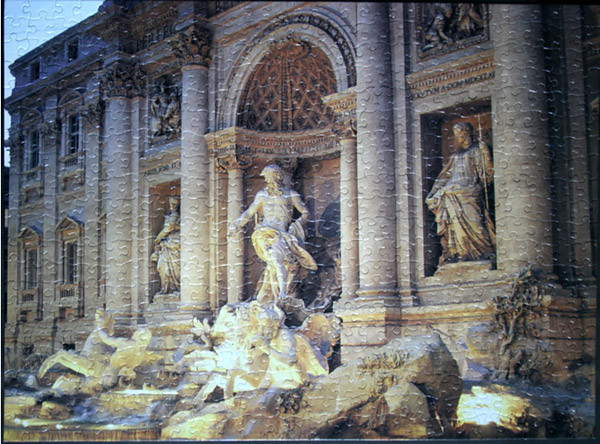
Size: 500 pieces
Dimensions: 48.26 cm x 35.56 cm
Producer: Sure-Lox, Land Marks series
Box: photo
Notes: The Trevi Fountain (Italian: Fontana di Trevi) is a fountain in the Trevi rione in Rome, Italy. Standing 25.9 meters high and 19.8 meters wide, it is the largest Baroque fountain in the city and one of the most famous fountains in the world.
The fountain at the junction of three roads (tre vie) marks the terminal point of the “modern” Acqua Vergine, the revived Aqua Virgo, one of the ancient aqueducts that supplied water to ancient Rome. In 19 BC, supposedly with the help of a virgin, Roman technicians located a source of pure water some 13 km from the city. (This scene is presented on the present fountain’s facade.) [Wiki]
Puzzle: Italian Feast
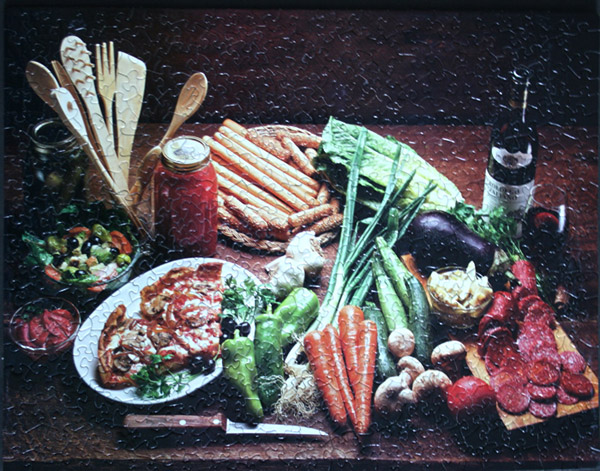
Size: 500 pieces
Dimensions: 35.56 cm x 45.72 cm
Producer: PuzzleMakers International
Box: photo
Notes: An Italian feast opens with antipasti (literally, “before the meal”), or appetizers. The antipasti is followed by the primi, consisting of a light pasta or soup. The main dish, secondi, is a meat or a fish platter. Some recipes will call for braciole, which means cutlets with the bone. The secondi is served with the fourth course in an Italian feast, the contomi, a side dish of vegetables. The Italian meal ends with dolce, equivalent to dessert: pastries like zeppole, served on St. Joseph’s day; doily-like cookies called pizelle; biscottis (twice-baked cookies that give an interesting crunch). Coffee is usually served after the meal. [See Italia site]
There is a book by Antonio Carpuccio called “Italian Feast” that features “a collection of over 100 recipes by Antonio Carluccio, Italian food’s greatest champion, that take the best of the old and the most delicious of the modern to create food that is as full of passion as it is flavour.” [Italian Feast book site]
Puzzle: Taste of Tuscany, Bella Piazza
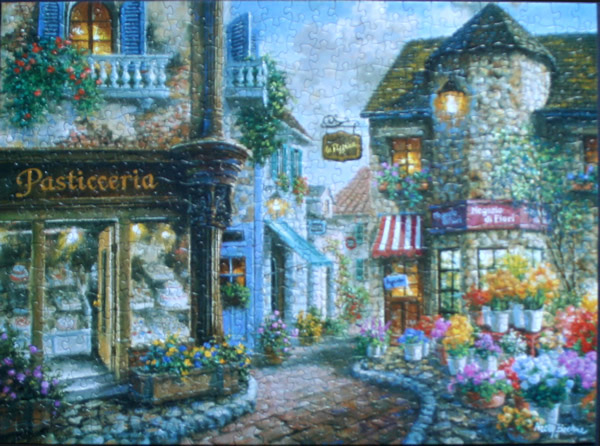
Size: 500 pieces
Dimensions: 48.26cm x 35.56cm
Producer: The Canadian Group, Sure-Lox, Taste of Tuscany series
Notes: A piazza is a city square in Italy, Malta, along the Dalmatian coast and in surrounding regions. The term is roughly equivalent to the Spanish plaza. In Ethiopia, it is used to refer to a part of a city. [Wiki]
Plaza is a Spanish word related to “field” which describes an open urban public space, such as a city square.[1] All through Spanish America, the plaza mayor of each center of administration held three closely related institutions: the cathedral, the cabildo or administrative center, which might be incorporated in a wing of a governor’s palace, and the audiencia or law court. The plaza might be large enough to serve as a military parade ground. At times of crisis or fiesta, it was the space where a large crowd might gather. Like the Italian piazza, the plaza remains a center of community life that is only equaled by the market-place. [Wiki]
Puzzle: Venice
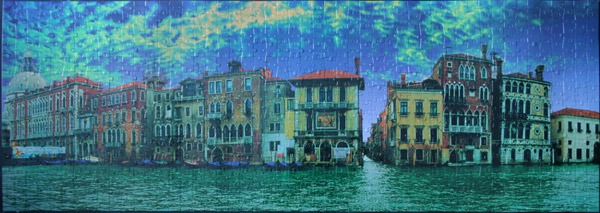
Size: 750 pieces
Dimensions: 86.36cm x 30.48cm
Producer: The Canadian Group, Sure-Lox, Panorific series
Notes: Venice (Italian: Venezia) is a city in northern Italy known both for tourism and for industry, and is the capital of the region Veneto, with a population of about 270,660 (census estimate 30 April 2009).
The name is derived from the ancient people of Veneti that inhabited the region as of 10th century B.C. The city historically was the capital of the Venetian Republic. Venice has been known as the “La Dominante”, “Serenissima”, “Queen of the Adriatic”, “City of Water”, “City of Masks”, “City of Bridges”, “The Floating City”, and “City of Canals”. Luigi Barzini, writing in The New York Times, described it as “undoubtedly the most beautiful city built by man”.
The city stretches across 117 small islands in the marshy Venetian Lagoon along the Adriatic Sea in northeast Italy. The saltwater lagoon stretches along the shoreline between the mouths of the Po (south) and the Piave (north) Rivers. [Wiki]
Puzzle: Passage to San Marco by Bob Pejman
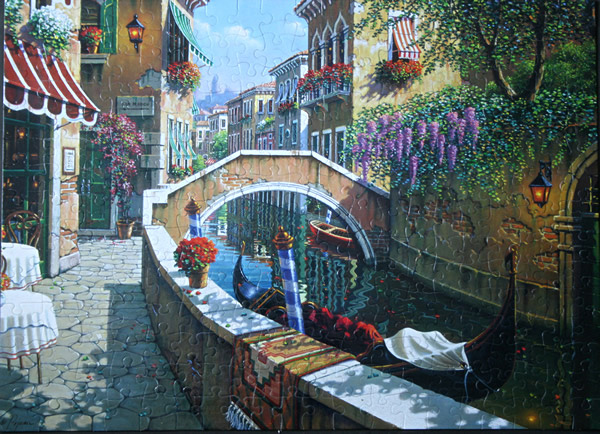
Size: 300 pieces
Dimensions: 67cm x 48cm
Producer: Hasbro, EZ Grasp
Painting: photo
Artist: Bob Pejman – “In his works, Pejman creates idyllic, tranquil worlds. “There are no people in my paintings, so you can imagine yourself in the scenes”, explains the artist. “The scenes are already romantic, but my idea is to make them even more so”. In doing so, he pushes the colors to make them more intense and exaggerates the sunlight. “I don’t simplify the shapes. You get into the cracks and feel the structures and the stones”, he says, considering them to be marks of cultivated wisdom rather than declination. There is romance in history, and Pejman reminds the viewer of classic beauty and emotions that transcend time, all inherent to such places as the Mediterranean.” [Bob Pejman bio]
Notes: “I was inspired to paint this oil painting of Venice in July of 2000, when I was visiting Italy.
On a sunny afternoon on my way to the San Marco Square, I passed through a narrow passage way by the Grand Canal. There was a trattoria on the corner and a gandola tied to a post in the narrow canal. This quiet and romantic spot captivated me to the extent that I stopped for a short while to do a rough sketch of this site, as I knew that I would paint a large scale oil painting of this location upon my return to the States.” [Bob Pejman site]
Puzzle: San Pietro by Rod Chase
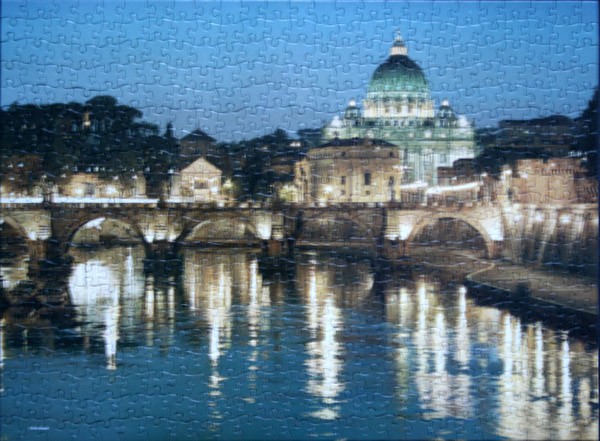
Size: 500 pieces
Dimensions: 48.26cm x 35.56cm
Producer: The Canadian Group, Sure-Lox
Artist: Rod Chase, Photorealist
Painting: The Glory of San Pietro
Notes: This view is from across the Tiber River looking toward St. Peter’s. I spent the evening photographing this scene during the twilight hours on our last night in Rome. The composition is based on one specific photo while dozens of additional photos were used to provide details for the architectural features. I especially enjoyed painting the reflections on the water, an exercise in abstract line and shape. The colors were muted to faded blues and Terra Cotta tones, which provide a more monochromatic color scheme representing the incredible history and beauty in Rome, and Italy in general. [Rod Chase]






